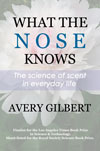
When it comes to figuring out at the molecular level why things smell the way they do, there is no better scientific source than the quaintly titled Journal of Agricultural and Food Chemistry.
Today’s journal reflects the revolution in fragrance and flavor analysis achieved by gas chromatography—mass spectrometry in the mid-1970s. (See? It wasn’t a totally lost decade, Jimmy Carter and leisure suits notwithstanding.) It’s were I found my WTNK material for the aroma similarities of lychee fruit and Gewurztraminer wine, the freshness (or not) of Moroccan sardines, and the characteristic smell of Asian fish sauce.
So what did they find? Well, a bunch of the polyfunctional thiols (sulfur-containing molecules like 3-sulfanylpropyl acetate) that give young Sauternes “the distinctive citrus nuances of young botrytized wines” are lost during the first year in the bottle. Other key odorants were still present five to six years after harvest, including fermentation alcohols like 2-phenylethanol and molecules such as vanillin, eugenol, and β-damascenone, which arise from the wine’s maturation in oak barrels. There was also α-terpineol which gives Sauternes its varietal aroma and sotolon, last noted hovering over the New York metropolitan region and triggering false medical diagnoses in the Middle East.
You don’t have to be a chem geek to be fascinated by this: now we know the whys and wherefores of how Sauternes changes character in the bottle. That’s just cool. And it hardly detracts from the allure of the wine or the joy experienced in the drinking of it. The perfume industry should be taking notes. (Yes, Rochelle Bloom, I’m talking to you.)
The second JAFC paper is by a French team who looked at low-concentration chemicals responsible for the berry notes in red Bordeaux wine. (These days fruity white wines are all the rage, but compounds associated with fruity aromas have been detected in reds as well. Berry notes in wine include red and black cherry, plum, black current, raspberry and strawberry.)
The French team, led by Bénédicte Pineau, fractionated various reds using methods designed to preserve as much of the fruity character as possible. They used GC-O and GC-MS analysis to identify the responsible molecules, and then spiked de-aromatized wine with specific chemicals to reconstruct the fruity aroma profiles. They found that “black berry” aroma was associated with higher levels of ethyl propanoate, ethyl 2-methylpropanoate, and ethyl 2-methylbutanoate. “Red berry” aroma was linked to ethyl butanoate, ethyl hexanoate, ethyl octanoate and ethyl 2-hydroxybutanoate.
All good and quite informative. But what really grabbed me were the odor threshold results. Most of the red- and black-berry aromas in Bordeaux were present at levels below those detectable by the human nose; nevertheless they contribute to the fruity character of the wine. It’s a phenomenon I addressed in WTNK: the myriad naturally-occurring odorants that hover just beyond direct detectability, yet which somehow add to our sensory experience of food and drink.
The third JAFC paper to catch my eye was by a Japanese team led by Takayuki Tamura at the Mercian Corporation. They investigated the fishy aftertaste that can occur when wine is paired with seafood. Using dried scallop as the sample seafood, a sensory panel rated all sorts of red and white wine for fishy aftertaste. Chemical analysis revealed that fishiness was positively correlated with the concentration of total iron and ferrous ion in the wines. Adding ferrous ion to a model wine boosted the fishy aftertaste; chelating the iron (soaking it up with a molecular sponge) reduced fishiness. Finally, the molecules responsible for fishy aftertaste (hexanal, heptanal, and 1-octen-3one) are increased when dried scallop is soaked in wine with higher levels of ferrous ion.
Tamura et al. deliver an open-and-shut case: iron is essential in causing the formation of fishy aftertaste in wine and seafood pairings. Very cool.
So tonight let’s lift a glass and savor the fruity notes; take a sip after some seafood and note the result; and finish things off with a nice Sauternes. Cheers!




No comments:
Post a Comment